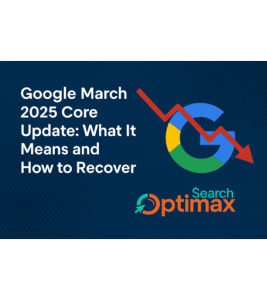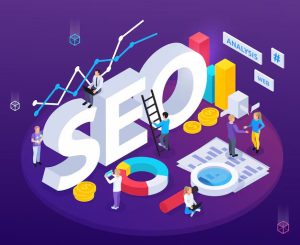How E-Commerce SEO Can Drive Traffic and Sales to Your Online Store

Introduction
E-commerce SEO is a strategy that helps online stores appear in search engine results, such as Google or Bing. It is all about using the right keywords, making the site easy to use, and creating content that attracts search engines. Every online store wants to be found by customers. SEO helps them get noticed by search engines. Without good SEO, an online store might get lost in a sea of other websites. Search engine optimization (SEO) is vital for the success of any online store, as it directly impacts how visible a website is on the internet.
What is SEO for E-Commerce?
E-commerce SEO means improving an online store’s website so that it ranks higher on search engines. When users search for products, an online store that has optimized SEO will show up on the search results page. Good SEO helps stores get noticed, drive traffic, and increase sales. This is a must-have for any business that operates online.
Why E-Commerce SEO Matters
E-commerce SEO is crucial because it helps businesses show up on search engines like Google. When users search for products, the websites that show up first get the most traffic. This leads to more customers, higher sales, and greater visibility for the brand. SEO brings organic traffic, which means users come without paid ads. This is why SEO is a powerful tool for e-commerce success.
How SEO Improves Visibility for E-Commerce
SEO increases product visibility by improving rankings on search engines. Small businesses can compete with larger stores when they use SEO. SEO helps stores get found by people looking for specific products. When businesses use SEO, they can make their product pages easier to find. It also helps in building a strong brand presence across the web.
Understanding the Basics of E-Commerce SEO
E-Commerce SEO vs. Traditional SEO
E-commerce SEO focuses on improving the ranking of online stores in search results. Traditional SEO is about ranking websites, blogs, and other content. For online stores, SEO is a little more complex. You need to optimize many product pages, handle large inventories, and make sure the website works well. The goal is to make sure every product page is easy to find when a user searches for a product.
Key E-Commerce SEO Elements
E-commerce SEO has three main parts: on-page SEO, technical SEO, and off-page SEO. On-page SEO is about optimizing product pages. This includes titles, descriptions, and images. Technical SEO focuses on the backend of the website. It ensures that the website loads fast, is mobile-friendly, and is easy to navigate. Off-page SEO involves getting backlinks from other websites. These links help increase the site’s authority.
SEO for E-Commerce Platforms
Different platforms have different needs. For example, Shopify, WooCommerce, and Magento each require specific SEO techniques. These platforms offer built-in tools to help with SEO. But you must customize them to get the best results. Plugins and themes on these platforms can also improve SEO. The right tools can make it easier for e-commerce stores to rank higher in search results.
Keyword Research for E-Commerce SEO
Why Keyword Research is Important
Keyword research is the first step in any SEO strategy. It helps you find the words and phrases that people use to search for your products. By using these keywords on your website, you can improve your chances of showing up in search results. Research tools like Google Keyword Planner, Ahrefs, SEMrush, and Moz help businesses find the right keywords for their store.
Primary vs. Secondary Keywords
Primary keywords are the main words that describe the product, like “buy wireless headphones.” Secondary keywords are variations or specific details related to the product, like “best noise-canceling headphones 2025.” These secondary keywords help target long-tail searches, which are more specific and less competitive. Using both types of keywords helps improve product page visibility.
Long-Tail Keywords and Customer Intent
Long-tail keywords are longer phrases that people search for when they want something specific. For example, “best waterproof Bluetooth headphones for jogging” is a long-tail keyword. These keywords are valuable because they attract people who are closer to making a purchase. By using long-tail keywords, online stores can connect with customers who know exactly what they want.
Keyword Tools for E-Commerce SEO
Using keyword tools can help e-commerce stores find the best keywords for their products. These tools provide data on how many people search for specific terms and how competitive they are. This helps businesses choose the right keywords to target for maximum visibility. For example, if you sell organic skincare, you can search for keywords related to skincare and see which ones are popular.
On-Page SEO for E-Commerce Stores
Optimizing Product Pages for SEO
Product pages need to be optimized for SEO. This starts with creating SEO-friendly product title tags. These tags should clearly describe the product and include relevant keywords. Product descriptions should also use keywords while providing useful information for customers. Meta descriptions are short, catchy descriptions that show up in search results. Crafting them carefully can improve click-through rates.
Internal Linking Structure
An internal linking structure helps users navigate the website easily. By linking product pages, categories, and related blog posts, you help customers find what they need. Internal links also help search engines crawl your site. Linking to similar products or categories can improve rankings.
Image SEO and Optimization
Images are an important part of any online store. By adding alt-text to images and using the right file types, you can make your images more SEO-friendly. Image compression tools that can help reduce file size, speeding up page load times. Proper image SEO is essential for both user experience and search engine ranking.
Creating SEO-Friendly URLs
Product URLs should be simple and descriptive. Avoid using random numbers or special characters. Instead, use keywords that describe the product, like “/women-s-clothing/casual-dresses.” This helps both search engines and users understand what the page is about.
Rich Snippets and Schema Markup
Rich snippets use structured data to display extra information in search results, like ratings or price. This makes your product stand out in search results, which can increase click-through rates. Schema markup helps search engines understand your content better, leading to better rankings.
Read more: Top Ecommerce Website Design Trends in 2025
Technical SEO for E-Commerce Websites
Mobile Optimization for E-Commerce
More people are shopping on mobile devices, so it’s important for e-commerce websites to be mobile-friendly. A mobile-optimized site ensures that users can easily browse and shop on their phones. Google prioritizes mobile-first indexing, so websites that work well on mobile are more likely to rank higher.
Speed Optimization for E-Commerce Websites
Website speed is crucial for a good user experience. Slow-loading pages can lead to high bounce rates and lower rankings. Tools like Google PageSpeed Insights and GTMetrix help you test website speed. Reducing image sizes, optimizing code, and using caching can speed up your website.
Website Security and HTTPS
SSL certificates keep your website secure and show customers that their information is protected. Google uses HTTPS as a ranking factor, so switching to HTTPS can boost SEO. Websites with SSL certificates rank better in search results.
URL Structure and Site Architecture
A clean, organized URL structure helps search engines crawl your website better. Using categories and subcategories for your products makes it easier for users to navigate. This structure also helps search engines understand your site’s content and rank it accordingly.
Avoiding Duplicate Content
Duplicate content can confuse search engines and harm rankings. Use canonical tags to indicate the preferred version of a page. Ensure that product descriptions are unique and not copied from manufacturers.
Off-Page SEO for E-Commerce
Backlink Building for E-Commerce Stores
Backlinks are links from other websites that point to your store. These links help improve your site’s authority and ranking. To get backlinks, you can use strategies like guest blogging, partnerships, and influencer marketing.
Social Media and Content Marketing
Social media can indirectly impact SEO by driving traffic to your site. Shareable content like blog posts or videos can increase engagement and bring more people to your website. Platforms like Instagram, Pinterest, and Facebook are great for sharing e-commerce content.
Leveraging User-Generated Content
User-generated content like reviews and testimonials can improve SEO. Reviews provide fresh content that search engines value. They also help customers make decisions and improve trust in your brand.
Content Marketing Strategies for E-Commerce SEO

How Blogs Can Boost E-Commerce SEO
Blogging helps drive organic traffic by targeting long-tail keywords. By creating content around your products, you can capture more searches and direct visitors to your e-commerce store. Blog posts also help build authority and trust with customers.
User-Generated Content and Reviews for SEO
Encouraging reviews and feedback from customers adds valuable content to your site. Positive reviews not only boost SEO but also provide social proof. This can influence other customers to make a purchase.
Video Content Marketing for E-Commerce
Video content can be a powerful tool for e-commerce SEO. Product demonstrations or tutorials can increase engagement and improve rankings. Optimize videos for platforms like YouTube and embed them on product pages for better results.
Tracking and Analytics for E-Commerce SEO

Google Analytics and E-Commerce Tracking
Google Analytics helps track e-commerce performance. You can monitor metrics like conversion rates, cart abandonment, and average order value. This data helps you adjust your strategy for better results.
Google Search Console for E-Commerce Performance
Google Search Console provides insights into how your site is performing in search results. It shows which keywords are driving traffic, helps you find crawl errors, and provides recommendations for improvements.
A/B Testing for Product Pages
A/B testing helps optimize product pages. By testing different versions of product titles, descriptions, or images, you can find out which ones work best for SEO. Tools like Optimizely and Google Optimize can help with A/B testing.
Common E-Commerce SEO Mistakes to Avoid
Overlooking Mobile Optimization
Neglecting mobile optimization can lead to poor user experience and lost sales. Ensure your website is responsive and works well on all devices.
Failing to Monitor SEO Performance
Regularly check your site’s performance. Use SEO tools to monitor keyword rankings, traffic, and page health. This helps you stay ahead of competitors and improve over time.
Not Addressing Duplicate Content
Duplicate content can hurt your SEO. Use canonical tags to prevent search engines from indexing multiple versions of the same page.
Using Poor Product Descriptions
Unique, detailed product descriptions are important. Avoid using generic content and provide helpful information that adds value for customers.
Frequently Asked Questions (FAQs)
What is the difference between on-page SEO and technical SEO for e-commerce?
On-page SEO focuses on optimizing product pages, titles, and descriptions, while technical SEO involves improving website architecture, speed, and mobile optimization.
How long does it take for e-commerce SEO to show results?
SEO results can take several months, depending on the competition and how well the store is optimized.
What are some quick wins for e-commerce SEO?
Improving product descriptions, optimizing images, and building backlinks are some quick ways to improve SEO.
How can I improve my site’s ranking in competitive markets?
Focus on long-tail keywords, create unique content, and build quality backlinks to improve rankings in competitive markets.
Conclusion
E-commerce SEO is an ongoing strategy that requires regular attention and optimization. By focusing on keyword research, on-page SEO, technical SEO, and off-page SEO, you can improve your online store’s visibility and drive organic traffic. Investing in SEO leads to long-term benefits, including higher search engine rankings, more traffic, and increased sales. Keep updating your strategies to stay ahead of competitors and adapt to changing SEO trends.







